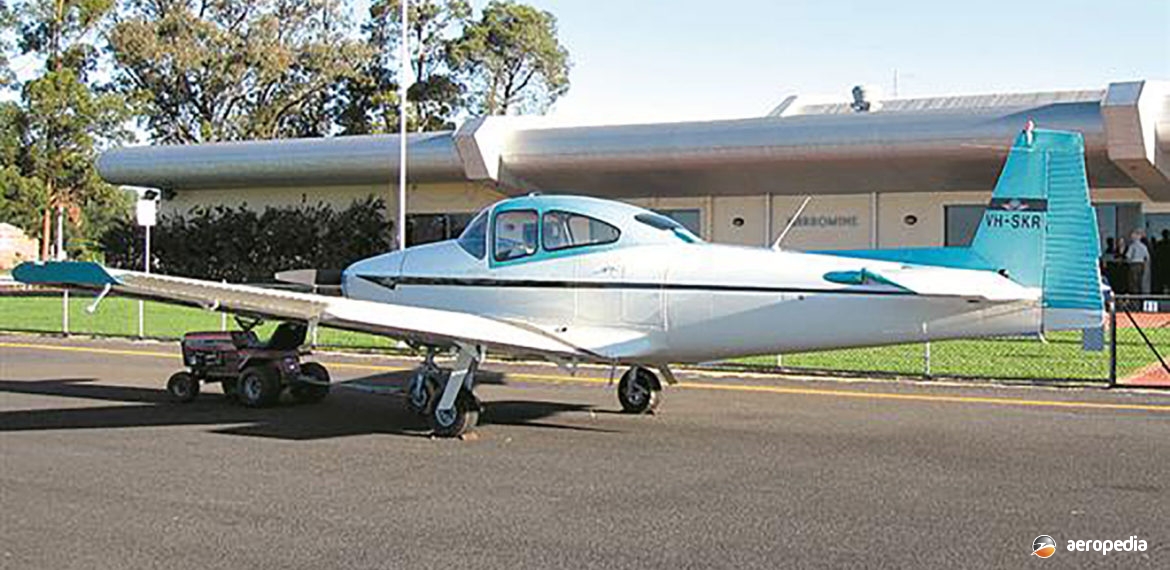Photograph:
Ryan Navion VH-SKR (c/n 4-1327) after completion of its rebuild at Narromine, NSW in 2016 (David C Eyre)
Country of origin:
United States of America
Description:
Two-seat training and touring aircraft
Power Plant:
One 153 kw (205 hp) Continental E-185-3 or -9 six-cylinder horizontally-opposed air-cooled engine
Specifications:
- Wingspan: 10.01 m (33 ft 4½ in)
- Length: 8.32 m (27 ft 3 in)
- Height: 2.66 m (8 ft 7½ in)
- Wing area: 17.18 m² (185 sq ft)
- Max speed: 262 km/h (163 mph)
- Cruising speed at 1,859 m (6,100 ft): 249 km/h (155 mph)
- Economical cruising speed: 185 km/h (115 mph)
- Initial rate of climb: 274 m/min (900 ft/min)
- Service ceiling: 4,755 m (15,600 ft)
- Range: 805 km (500 miles)
- Fuel capacity: 303 litres (66.6 imp gals)
- Empty weight: 808 kg (1,782 lb)
- Loaded weight: 1,247 kg (2,750 lb)
History:
The Navion was designed by North American Aviation as the NA-143, later the NA-145, and major production in some numbers was by Ryan Aeronautics to the extent that some 1,238 examples were constructed in the years 1948 to 1950, the latter acquiring the rights to the design in 1947. Initial variant was the Model 205, and later Ryan introduced the Super 260 with a 194 kw (260 hp) Lycoming GO-435-C2 engine. This model was a four-seater. Production of the series ended in 1951 and later the design was developed by the Ryan Aircraft Company as the Rangemaster.
North American was looking to sell a light aircraft after World War II and created the Navion, production commencing at the Company’s facility at Inglewood in California. It was designed to be easy to fly, fast, have a large cabin for its class and able to operate from short rough strips. One example was built as the Model 72, a trainer, for the USAF, but the contract was awarded to the Beech T-34 Mentor. However, variants of the Model 154 were supplied to the USAF, the L-17A being for liaison and training for university Reserve Officers Training Corps, 83 being delivered, 35 of these later being converted by Schweizer Aircraft to bring them up to L-17B specifications, this including the installation of an auxiliary fuel tank. The L-17B, of which 163 were built, was the military variant of the Navion B for the USAF.
First production batch had a 138 kw (185 hp) Continental engine, this being replaced in the Navion A by the 153 kw (205 hp) unit. A total of 1,027 was built by North American, including examples produced for the US Army. Following the onset of the Korean War, North American turned its facilities to producing large numbers of North American Sabres and Ryan took over production, building 1,206 Navion and Navion As, and 222 Navion Bs, with the 194 kw (260 hp) Lycoming engine. Following a decline in sales, production ceased in 1951. Later a company called Tusco re-engined a number of examples, these becoming known as the Navion D, E and F Models with 179 kw (240 hp), 186 kw (250 hp) and 194 kw (260 hp) engines respectively, and fitted them with wing-tip fuel tanks. A few were converted to twin engine configuration, becoming known as the Camair Twin Navion and the Temco-Riley D-16A Twin Navion; and some military aircraft were converted for target drone duties.
Military operators included the USAF, US Army, US Air National Guard and the air force of the Dominican Republic. First example imported to this region was imported in mid-2010. This aircraft was to be assembled for its owner in central New South Wales, having the registration VH-SKR² (c/n 4-1327 – ex N4327K, NC4327K) issued to Mr K Radke of Dubbo on 4 August 2010. The aircraft was fitted with a Continental E-225 engine. However, when it arrived the aircraft had been badly damaged during shipment and consideration had to be given to a complete rebuild of the fuselage. Later ownership of the aircraft, still registered as VH-SKR², was transferred to William Mailer of Riddells Creek, VIC, and restoration began, the aircraft being completed in 2016 and being noted at Narromine, NSW for sale. On 1 March 2017 it became VH-WRM.

